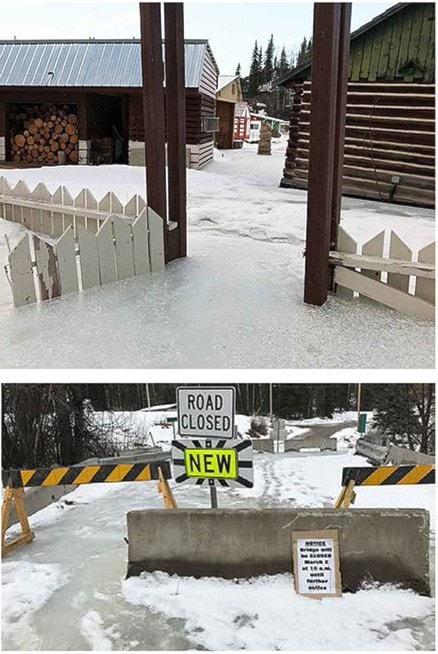Several agencies have worked together to address a flooding caused by a frozen stream channel on Hawse Loop Road, approximately 15 km east of Burns Lake, that had been affecting local residents for weeks.
Hawse Loop Road resident Ron Braaten first noticed the flooding at the start of the year.
“This is the first time that the creek has actually run all year long, so basically what happened is that the creek kept freezing on top of itself until it [the water] came on the top of the creek bank and it started flowing everywhere,” he described. “It eventually blocked the bridge off; it actually lifted the bridge; it was just a really dramatic scenario.”
“The situation got progressively worse and worse,” he continued. “It finally came to our yard and engulfed the bottom of our wood shed, and part of our patio got flooded.”
The stream channel ice removal was coordinated by the Ministry of Transportation and Infrastructure and involved the Regional District of Bulkley-Nechako, Lakes District Maintenance (LDM), Ministry of Forests Lands and Natural Resource Operations, Emergency Management B.C. and local environmental consultants.
It took the agencies two days to complete the ice removal and restore the creek channel.
Two small excavators were used for the ice removal. One machine used a ripper claw while the other used a rock bucket to load the ice into a tandem dump truck. Lakes District Maintenance also used their steamer unit to open a number of holes in the ice under the Hawse Loop Bridge to restore water flow.
Braaten said the flooding could've been a lot worse if the agencies hadn’t intervened.
“Without that creek being de-iced, we would’ve been hit hard here with the spring runoff,” he said. “We have nothing but praise to give them right now.”
When asked why the ministry didn’t address this issue sooner, Danielle Pope, a spokesperson for the Ministry of Transportation and Infrastructure, said the ministry and LDM observed ice rising under the Hawse Loop Bridge earlier this year and regularly monitored the situation.
“It was observed at that time that the downstream and upstream channel were fully frozen,” she explained. “The Ministry of Transportation and Infrastructure worked with other agencies to examine if any remedial action could be undertaken; as freshet [spring runoff] was approaching, we worked with other agencies to remove some of the ice and restore the original stream channel.”
When asked if this was a temporary or a permanent solution, the Ministry of Transportation said it can be difficult to predict what natural events may occur in the future.
“But the Ministry of Transportation and LDM regularly monitor our road network and weather forecasts to address any issues that may arise,” said Pope.
Braaten said this was the first time that a flooding occurred on Hawse Loop Road since he moved to the area in 1999. He said local residents are now concerned that this issue might happen again in the future.
“We are a little concerned because if it happened once, who’s to say this won’t happen every year now," he said. "So we might have to figure something out a permanent solution; hopefully we won’t have to deal with this every year.”
Across northwest B.C., the Ministry of Transportation has experienced an unprecedented amount of frozen culverts and ditch glaciation this year.
“This was precipitated by arctic temperatures, minimal insulating snow cover and ground water continuing to run during the winter,” said the ministry in a statement. “This winter our frost probes recorded depths of frost much deeper than normal.”
